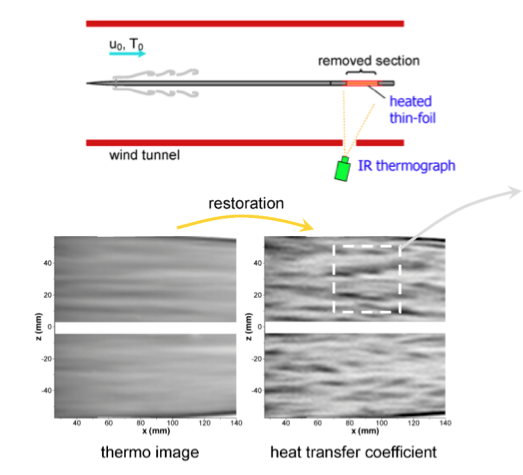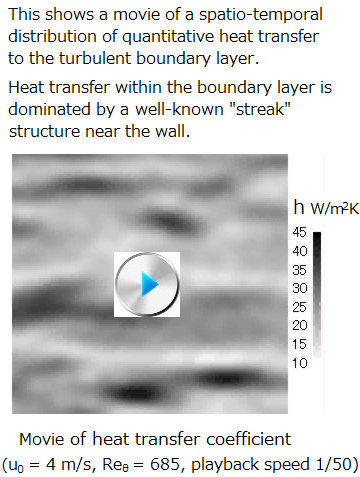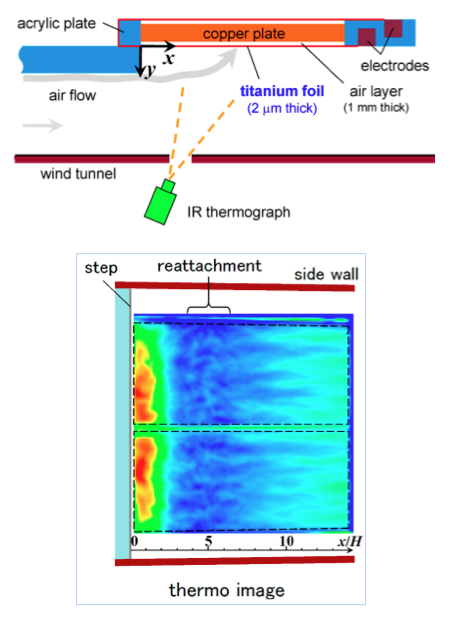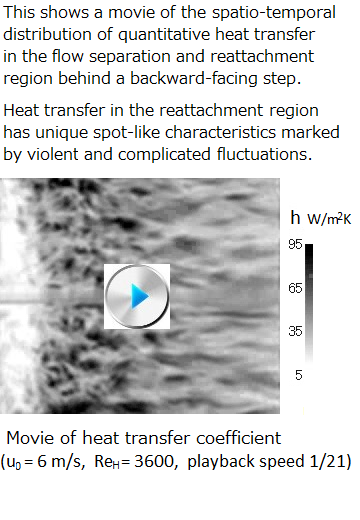Unsteady Heat Transfer Measurement Using Infrared Thermography
1. Principle
If heated thin-foil is exposed to a fluid flow without contact with a solid surface, the temperature on the foil fluctuates according to variation of the heat transfer between the foil and the fluid. Thus, we can observe the spatio-temporal variation of the convective heat transfer reflected by flow turbulence by measuring the temperature fluctuation on the foil using high-speed infrared thermography.
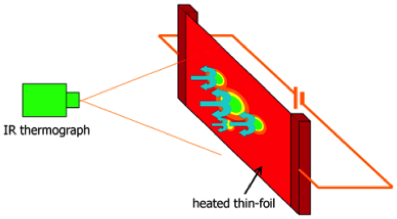
2. Frequency response and space resolution
If thermal inertia of the heated thin-foil is sufficiently small, we can observe the fast fluctuation of the heat transfer. However, if the fluctuation frequency becomes higher, the temporal amplitude attenuates and ultimately becomes indistinguishable from noise. Similarly, if lateral heat conduction in the foil is sufficiently small, we can observe the fine spatial structure of the heat transfer. However, if the spatial structure becomes finer, the spatial amplitude attenuates and ultimately becomes indistinguishable from noise. In this work, heat conduction analysis was performed to derive general relationships between upper limits of both the fluctuating frequency and the spatial wavenumber of the heat transfer, which are detectable using infrared thermography.

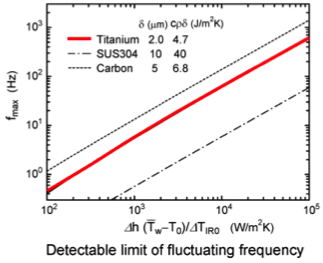
[main literature]
3. Measurement for turbulent boundary layer
We tried to measure the spatio-temporal distribution of the heat transfer on the wall of a turbulent boundary layer in order to confirm that this technique can be applied to measure the heat transfer caused by flow turbulence. Although the time and spatial structure in the heat transfer attenuated due to the thermal inertia and lateral conduction of the heated surface, the attenuation was restored by solving the inverse heat conduction equation to evaluate the local and instantaneous heat transfer coefficient quantitatively. As a result, we successfully demonstrated that the spatio-temporal structure in the heat transfer was dominated by the dynamic feature of the thermal streaks. This indicates that this technique is promising for examining the unsteady nature of turbulent heat transfer to the airstream.
[main literature]
- Measurements of Time-Space Distribution of Convective Heat Transfer to Air Using a Thin Conductive-Film, 5th Int. Symp. on Turbulence and Shear Flow Phenomena (2007) München, Germany, pp.773-778
- Quantitative Evaluation of Spatio-Temporal Heat Transfer to a Turbulent Air Flow Using a Heated Thin-Foil, Int. J. Heat and Mass Transfer, 64 (2013), 892-902
4. Measurement for separated and reattaching flows
We measured spatio-temporal distribution of convective heat transfer accompanying flow separation and reattachment, such as a backward-facing step flow. Although the time-averaged characteristics of the heat transfer had previously been measured extensively, the present measurements have clarified the following: (1) The heat transfer in the flow reattaching region fluctuates violently and is highly nonuniform to have complicated spot-like characteristics; (2) The instantaneous distribution of the heat transfer has quasi-periodicity of approximately a step height in the spanwise direction.
[main literature]
- Spatio-Temporal Characteristics of Turbulent Heat Transfer for a Backward-Facing Step Flow, Trans. Jpn. Soc. Mech. Eng., 76-771 B (2010), 1870-1878 (in Japanese)
- Spatio-Temporal Characteristics of Heat Transfer in Separated and Reattaching Flows, Proc. ASME-JSME-KSME Joint Fluids Engineering Conf. (2011) Hamamatsu, Shizuoka, AJK2011-25020
